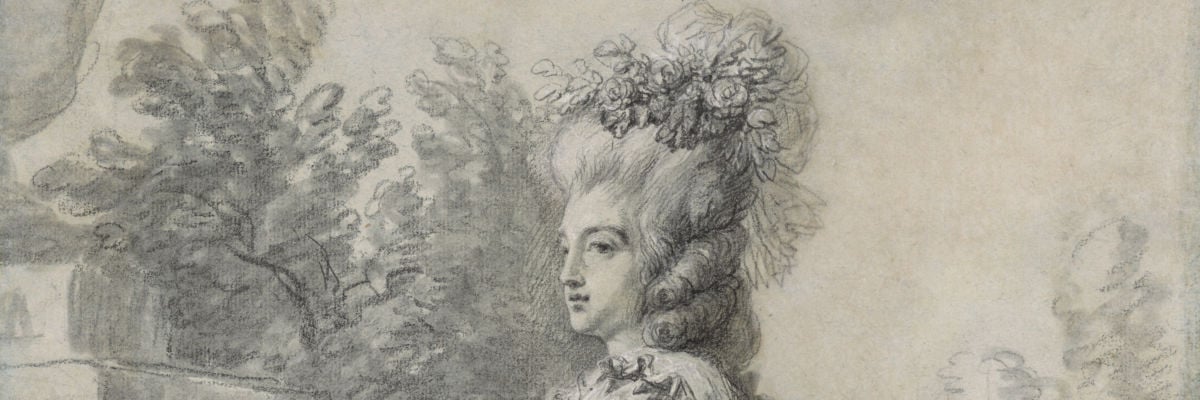
On October 16, 1793, in the Parisian public square once dedicated to her husband’s grandfather, Louis XV, Marie-Antoinette of Austria, widow of Louis XVI, was decapitated on the new machine of public execution called the guillotine. She was two weeks away from her thirty-eighth birthday.
Why a daughter of the powerful Habsburg dynasty, who had been the wife of the most powerful ruler in Europe, would come to such a violent end has never ceased to haunt and fascinate historians. In the popular mind, she is the queen who danced while the people starved, who spent extravagantly on clothes and jewels without a thought for her subjects’ plight. Such is the image of the much-maligned Austrian archduchess, sent to France at age fourteen to marry the fifteen-year-old dauphin.
In reality, Marie-Antoinette was a teetotaler who ate frugally. She was notorious for her intense modesty. Yes, she had a gambling problem when young. She loved to entertain and had wonderful parties. Her clothes, yes, were magnificent; volumes could be and have been written about Marie-Antoinette’s style. She did gradually introduce simpler fashions to France, however. Her charitable works on behalf of the indigent were extensive.
But for her enemies, she stood between them and political power; she stood between them and destroying the Catholic Church; she stood between them and the complete overturning of society. As beloved wife of the king and as mother of not only the heir to the throne, but all the French people, she had to be destroyed.
Although some historians are intent upon proving that Marie-Antoinette had an extramarital affair with a Swedish diplomat, evidence of the queen’s fervent Catholic faith continues to surface. Recently auctioned in Paris was the Holy Week missal of the late queen Marie Leszczynska, the grandmother of Louis XVI. The book ended up in the hands of the king’s sister, Madame Elisabeth, who shared her brother’s imprisonment. When in prison, the royal family made use of the missal throughout the year, reading aloud the words of the Mass every day. Later, when Marie-Antoinette was taken to the Conciergerie for her trial, the prayer book went with her. To this day, the book opens easily to certain pages, including page 310, which has the passage:
Scarcely is he [Jesus] raised to the sight of all these people, that he is insulted, and charged on all sides with curses and reproaches. In the end, he makes one last effort to raise his eyes to heaven: my Father, he exclaims, forgive them, I pray you, because they know not what they do.
I first visited Marie-Antoinette’s private retreat at Petit Trianon when I was seventeen years old. It was January, but the birds were singing in the gardens. Then and on successive trips, I experienced a strong sense of timelessness. Others have confided to me a similar feeling of enchantment when wandering through the gardens of Trianon.
People frequently ask me why I write about Marie-Antoinette. One of the reasons is that I keep encountering educated people who really think she said, “Let them eat cake.” I continue to encounter Christians who think Marie-Antoinette was killed as punishment for some egregious wickedness or, at least, for unforgivable stupidity. Having read books about her since childhood, I knew she was misunderstood; it was only after a great deal more research that I came to see how completely false are the common beliefs about her.
But the demonization of Marie-Antoinette in the popular mind is necessary to justify the excesses of the French Revolution. When people have a false and distorted view of history, it is difficult for them to grasp the present, and almost impossible to meet the future with any kind of preparedness.
The French Revolution was not necessary, simply because it is never necessary to murder tens of thousands of people. Reform certainly was needed, but reform can happen without mass murder.
Louis XVI was an intrepid reformer. He was not afraid to break with the past and abolish outdated customs while introducing new ways of doing things. Louis was not resistant to change, although that is how he is usually portrayed. The changes were slow but over time might have been effective, had the violent upheavals not swept everything away.
Too often, the violence is represented as a sad but unavoidable means of achieving freedom and democracy. But it is not only that the French Revolution overturned the social order; it was ultimately an attack on the Catholic Church. Many Catholics were killed, especially those peasants who did not want their religion taken away.
The French Revolution has been the blueprint for every totalitarian regime that has followed and has continued to be the model for those wishing not only to destroy the Catholic Church, but all Christian society.
Modern people love Marie-Antoinette for her glamor and style, but mostly for her courage when the glamor disappeared. Hers is a tragedy akin to those of ancient Greece, yet without the element of total despair. For Antoinette remains a Christian heroine, and her end is characterized by virtues that can be found in many an acta sanctorum. Although we weep for her, we are simultaneously uplifted—for the hallmark of Christian charity involves the ability to forgive.
Whatever faults Marie-Antoinette may have had, there can be no doubt that she bore wrongs patiently and forgave her enemies in a Christlike manner. And her forgiveness has an especially supernatural aura. When she wrote her last letter to her sister-in-law Elisabeth, she was hours away from death. She was half-blind, and her health was broken. She had been put through the ordeal of a humiliating trial, designed to break her will. Her little son had been dragged from her arms and tormented into accusing his own mother of incest.
That Marie-Antoinette was able to forgive the monsters who had tried to destroy her by corrupting her little boy surely required a special grace from God. Here are her words to Elisabeth, who had also been falsely accused:
I have to speak to you of one thing which is very painful to my heart, I know how much pain the child must have caused you. Forgive him, my dear sister; think of his age, and how easy it is to make a child say whatever one wishes, especially when he does not understand it. . . . I pardon all my enemies the evils that they have done me.
Christian love overcomes hatred. Only someone who sincerely believed in and loved Jesus Christ could make that leap from hellish circumstances to the heights of courage, love, and martyrdom. And thus Marie-Antoinette, a wife and mother who had witnessed her family suffering, whose husband had been killed, whose little son had been tormented, is an example of Christian fortitude for all time.
For resources on Marie-Antoinette, readers can look below:
Bertière, Simone. Marie-Antoinette l’insoumise. Paris: Editions de Fallois, 2002.
Campan, Madame. Memoirs of Marie-Antoinette. New York: Collier and Son, 1910.
Delorme, Philippe. Marie-Antoinette: Épouse de Louis XVI, mère de Louis XVII. Paris: Pygmalion/Gérard Watelet, 1999.
Fraser, Antonia. Marie-Antoinette: The Journey. New York: Anchor Books, 2002.
Schama, Simon. Citizens: A Chronicle of the French Revolution. New York: Vintage Books, 1989
Seward, Desmond. Marie Antoinette. New York: St Martin’s Press, 1981.
Vidal, Elena Maria. Marie-Antoinette, Daughter of the Caesars. Mayapple Books: Saint Michaels, Maryland, 2016.
Webster, Nesta H. Louis XVI and Marie Antoinette before the Revolution. London: Constable, 1937.
—Louis XVI and Marie Antoinette during the Revolution. New York: Gordon Press, 1976.
Image courtesy of Bequest of Mrs. Charles Wrightsman, 2019.



